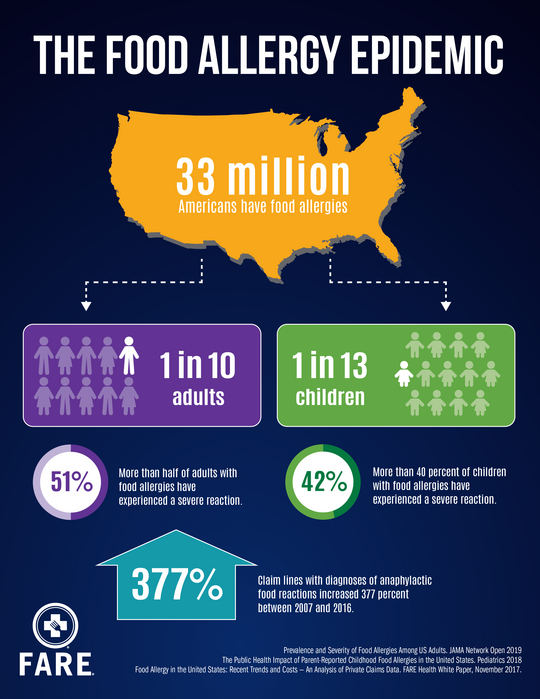New Prevalence Numbers Demand an Aggressive Call to Action
Two recently released large-scale studies of food allergy prevalence have resulted in an update of FARE’s frequently cited statistics that provide estimates on how many people are living with this potentially life-threatening disease.
Two recently released large-scale studies of food allergy prevalence have resulted in an update of FARE’s frequently cited statistics that provide estimates on how many people are living with this potentially life-threatening disease.
These new numbers – 32 million Americans, more than double what we previously believed – reinforce that food allergy is a problem of epidemic proportions.

“The Public Health Impact of Parent-Reported Childhood Food Allergies in the United States,” an update of a 2011 landmark study published in Pediatrics, reported that 5.6 million children have at least one food allergy. As FARE previously established, that’s 1 in 13 children, or roughly two in every classroom.
Those conclusions are in line with what we’ve known about how many kids are living with food allergy.
In contrast, the results of the second study, a survey estimating food allergy prevalence among a sample of over 40,000 adults, were surprising.
Based on these nationally-representative data, the authors concluded that an estimated 10.8 percent of US adults have at least one current food allergy. That’s more than 26 million people age 18 or older, nearly three times the 9 million previously reported.
The authors of “Prevalence and Severity of Food Allergies Among U.S. Adults,” published in JAMA Network Open in early January, developed a cross-sectional survey that provided means to eliminate those who believed they have a food allergy but did not report symptoms indicative of an IgE-mediated food allergy. This illuminated another concern, in that nearly 19 percent of adults believed that they were food-allergic.
These studies represent comprehensive and rigorous epidemiological research investigating food allergy in the pediatric and adult populations of the U.S. Their publication is a critical step in defining the scope of the food allergy problem, though more epidemiological research is needed to confirm and complement these survey findings. We are grateful to the dedicated investigators who have spent years studying the impact of food allergy in the U.S., and we encourage further research to build on what we have learned to date.
Moving forward, these survey data are a vital opportunity to amplify the voices of the food allergy community. Prevalence figures are used by government agencies, pharmaceutical companies, corporate entities and other research-funding bodies to decide how they should spend their resources. We now have evidence to show what we’ve long suspected: this is an epidemic.
We have made great strides in getting our needs heard. National Institutes of Health support for food allergy research has grown from just $4 million in 2004 to $79 million in 2017, and encouragingly, there are exponentially more clinical trials for food allergy today than there were 10 years ago.
But the resources dedicated to food allergy have not been proportionate to the breadth of the problem. Not even close.
There is no cure for food allergy. Every person who lives with this disease, who must carry medication that will save their life if they are accidentally exposed to their food allergen, deserves to be counted. And those 32 million Americans with food allergies equate to an urgent call to action that no one should ignore.
Recently FARE launched Contains: Courage™, a five-year fundraising and awareness campaign that seeks to transform the future for all those affected by food allergies by raising a historic amount of money for research including therapies and diagnostics to help alleviate the burden of the disease. We hope you will join us – on behalf of the 32 million Americans with food allergies.
Citations:
Gupta RS, Warren CM, Smith BM, Jiang J, Blumenstock JA, Davis MM, Schleimer RP, Nadeau KC. Prevalence and Severity of Food Allergies Among US Adults. JAMA Network Open 2019; 2(1):e185630.doi:10.1001/jamanetworkopen.2018.5630.
Gupta RS, Warren CM, Smith BM, Blumenstock JA, Jiang J, Davis MM, Nadeau KC. The Public Health Impact of Parent-Reported Childhood Food Allergies in the United States. Pediatrics 2018; 142(6):e20181235.


